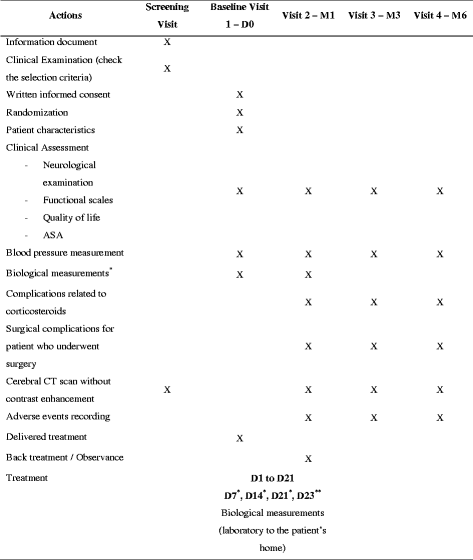Steroids in chronic subdural hematomas (SUCRE trial): study protocol for a randomized controlled trial
- PMID: 28583162
- PMCID: PMC5460366
- DOI: 10.1186/s13063-017-1990-8
Steroids in chronic subdural hematomas (SUCRE trial): study protocol for a randomized controlled trial
Abstract
Background: Chronic subdural hematoma (CSDH) is a common neurological pathology, especially in older patients. The actual "gold standard" of treatment is surgical evacuation, with various techniques used across neurosurgical teams. Over the years, there has been growing evidence that inflammatory processes play a major role in the pathogenesis of CSDH. In that context, the use of corticosteroids has been proposed alone or as an adjuvant treatment to surgery. However, this practice remains very empirical and there is a need for high-quality-of-evidence studies to clarify the role of corticosteroids in the management of CSDH.
Methods/design: We propose a double-blind, randomized controlled trial comparing methylprednisolone versus placebo in the treatment of CSDH without clinical and/or radiological signs of severity. The treatment will be administered daily for a duration of 3 weeks, at a dose of 1 mg/kg. The primary endpoint will be the delay of occurrence of surgical treatment at 1 month following the introduction of the treatment. Secondary endpoints will include the rate of recourse to surgery, survival rate, quality of life and functional assessments, occurrence of systemic secondary effects and radiological assessment of the response to treatment. This multimodal assessment will be done at 1, 3 and 6 months. Two hundred and two patients (101 per arm) are expected to be included considering our primary hypotheses.
Discussion: This trial started in June 2016; its results may open interesting alternatives to surgery in the management of patients harboring a CSDH, and may provide insights into the natural history of this common pathology.
Trial registration: ClinicalTrials.gov, ID: NCT02650609 . Registered on 4 January 2016. Graphical output of the OBF boundaries.
Keywords: Chronic subdural hematoma; Conservative treatment; Corticosteroids; Elderly patients; Methylprednisolone.
Figures
Similar articles
-
Tranexamic Acid in Chronic Subdural Hematomas (TRACS): study protocol for a randomized controlled trial.Trials. 2016 May 5;17(1):235. doi: 10.1186/s13063-016-1358-5. Trials. 2016. PMID: 27150916 Free PMC article. Clinical Trial.
-
The efficacy of dexamethasone on reduction in the reoperation rate of chronic subdural hematoma--the DRESH study: straightforward study protocol for a randomized controlled trial.Trials. 2014 Jan 6;15:6. doi: 10.1186/1745-6215-15-6. Trials. 2014. PMID: 24393328 Free PMC article. Clinical Trial.
-
Dexamethasone for adult patients with a symptomatic chronic subdural haematoma (Dex-CSDH) trial: study protocol for a randomised controlled trial.Trials. 2018 Dec 4;19(1):670. doi: 10.1186/s13063-018-3050-4. Trials. 2018. PMID: 30514400 Free PMC article.
-
Effect of Steroid Therapy on Risk of Subsequent Surgery for Neurologically Stable Chronic Subdural Hemorrhage-Retrospective Cohort Study and Literature Review.World Neurosurg. 2020 Jun;138:e35-e41. doi: 10.1016/j.wneu.2020.01.160. Epub 2020 Feb 27. World Neurosurg. 2020. PMID: 32113994 Review.
-
Drug treatment of chronic subdural hematoma.Expert Opin Pharmacother. 2020 Mar;21(4):435-444. doi: 10.1080/14656566.2020.1713095. Epub 2020 Jan 20. Expert Opin Pharmacother. 2020. PMID: 31957506 Review.
Cited by
-
Effect of postoperative tranexamic acid on recurrence rate and complications in chronic subdural hematomas patients: preliminary results of a randomized controlled clinical trial.Neurosurg Rev. 2023 Apr 18;46(1):90. doi: 10.1007/s10143-023-01991-9. Neurosurg Rev. 2023. PMID: 37071217 Free PMC article. Clinical Trial.
-
Hematoma-derived exosomes of chronic subdural hematoma promote abnormal angiogenesis and inhibit hematoma absorption through miR-144-5p.Aging (Albany NY). 2019 Dec 16;11(24):12147-12164. doi: 10.18632/aging.102550. Epub 2019 Dec 16. Aging (Albany NY). 2019. PMID: 31841443 Free PMC article.
-
The changing face of neurosurgery for the older person.J Neurol. 2020 Aug;267(8):2469-2474. doi: 10.1007/s00415-020-09854-9. Epub 2020 Apr 25. J Neurol. 2020. PMID: 32335794 Free PMC article. Review.
-
Statins as a Medical Adjunct in the Surgical Management of Chronic Subdural Hematomas.World Neurosurg. 2021 May;149:e281-e291. doi: 10.1016/j.wneu.2021.02.036. Epub 2021 Feb 18. World Neurosurg. 2021. PMID: 33610873 Free PMC article.
-
Epidural Hematoma: The Outcome of Glucocorticoids' Complementary Use to Surgical Treatment.Cureus. 2022 Feb 25;14(2):e22607. doi: 10.7759/cureus.22607. eCollection 2022 Feb. Cureus. 2022. PMID: 35371733 Free PMC article.
References
-
- Santarius T, Kirkpatrick PJ, Kolias AG, Hutchinson PJ. Working toward rational and evidence-based treatment of chronic subdural hematoma. Clin Neurosurg. 2010;57:112–22. - PubMed
-
- Bourgeois P, Sleiman M, Louis E, Haddad E, Touzet G, Fichten A, Lejeune JP. Chronic subdural hematoma in patients over 80 years of age. Neurochirurgie. 1999;45:124–8. - PubMed
-
- Cousseau DH, Echevarría Martín G, Gaspari M, Gonorazky SE. Chronic and subacute subdural haematoma. An epidemiological study in a captive population. Rev Neurol. 2001;32:821–4. - PubMed
-
- Kinsella K, Velkoff V. An aging world: 2001. Washington DC: US Government Printing Office; 2001.
Publication types
MeSH terms
Substances
Associated data
LinkOut - more resources
Full Text Sources
Other Literature Sources
Medical


